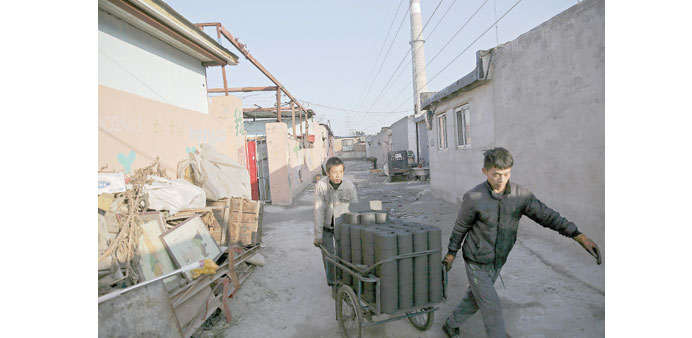RELIEF: Men deliver honeycomb briquettes for domestic use in an area next to a coal power plant in Beijing during a smog-free December 10 which was also the last day of the city’s first “red alert” for air pollution. Photo by Reuters
By Steff Gaulter
Sometimes the dust in Doha can be insufferable. When the wind picks up, I always wonder what I am breathing into my lungs and how much harm it’s doing. However, if you think it’s bad here, bear a thought for those living in China. The pollution in Beijing is so bad, that this week the first ever red alert was issued by the government.
Beijing is a city that generates a vast amount of pollution, at least in part thanks to China’s love of smoky coal-fired power stations. However, the pollution that is poured into the atmosphere isn’t the sole cause of the problem. If it were, then the pollution would be bad throughout the year. Unfortunately for Beijing, the poor air quality is exacerbated in winter.
China sits on the huge Eurasian landmass, which stretches nearly half way around the world, from Portugal on the Atlantic coast, to the easternmost point of Russia only 90 kilometres from North America. In winter, this vast expanse of land gets extremely cold. Cold air is dense and heavy, so as the temperatures drop, the heavy air starts to sink, pushing down on the earth. This sinking air suppresses any rainfall, which is unfortunate, as a decent downpour would help to clear the pollution from the atmosphere.
As the air pushes down on the ground, the pressure begins to rise and a large area of high pressure forms over the region. This acts as a lid on the atmosphere, trapping all the pollution near the ground. Many other locations could still hope for a strong wind to clear the pollutants, but in Beijing, this is made unlikely by the surrounding topography.
To the west and north of Beijing are huge mountains. These jut over 2,000 metres into the atmosphere, ensuring that only a very strong wind can make it over their vast peaks. Air can far more readily drift across the city from the south or the east, but the air from this direction isn’t clean. In data issued by the Ministry of Environmental Protection for the year 2013, the seven of the ten worst polluting cities in China were situated in Hebei Province, the province that surrounds Beijing. This ensures that any wind from the south or east will draw in extra pollution from the neighbouring cities and trap it over Beijing.
Obviously particles that cause pollution can come in all shapes and sizes. They are known as PM, which stands for ‘particulate matter’, and they are usually classed according to their dimension. The larger ones are called PM10, and these can be up to 10 microns in size, whereas the smaller ones are called PM2.5, which are under 2.5 microns in diameter. Both are clearly very small, but the smaller ones, the PM2.5 particles, are 100 times smaller than the width of a human hair.
PM10 particles are made up of smoke and dirt from factories and farming, as well as from tiny pieces of rocks and plant spores. They are generally created by grinding rocks or turning soil, and the particles are then blown by wind. PM2.5 particles, on the other hand, are toxic organic compounds and heavy metals. These finer particles are generated by the exhaust of vehicles, the burning of plants or by metal processing plants. The PM2.5 particles clearly sound more toxic than the larger particles, but this isn’t the only reason that they are more dangerous.
You might think that the smaller particles would do less damage to your health than the larger ones, but it’s actually the finer particles that are more dangerous. The larger ones are more likely to get stuck to the sides of your lungs, but the smaller particles can travel deeper into them. If the toxins become embedded, they can cause various lung diseases.
Unfortunately as well as being more hazardous, these finer particles can also spend longer suspended in the atmosphere. The larger ones will tend to settle out of the air after just a few hours, but the PM2.5 particles can travel for hundreds of kilometres and can stay in the air for days or even weeks. Recently it has been these dangerous PM2.5 particles that have caused the greatest concern in Beijing.
In order to clear the air in China, something has to change. The topography cannot be altered and neither can the climate, and the mountains and the area of high pressure that develops in winter will always act against the city. The only thing that can be changed is the amount of pollution in the atmosphere. Therefore if the government is really serious about clearing the air, then the issue of emissions has to be addressed and the polluting factories need to be cleaned up. This is the only way that Beijing can guarantee its skies will stay blue.



